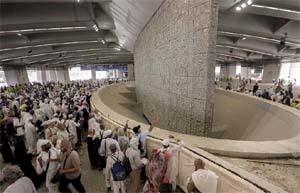World Desk : dhakamirror.com
The annual Hajj pilgrimage, one of the five pillars of Islam, is a time of deep spiritual reflection for millions of Muslims. One of the most significant rituals during Hajj is the stoning at Jamarat, where pilgrims throw pebbles at three pillars, symbolising the rejection of evil.
With over 1.84 million pilgrims participating this year, a staggering total of over 100 million pebbles were used in the ritual. Where do all these pebbles go after the ritual is completed?
As the valley of Mina and Jamarat become empty once again after the Hajj pilgrimage, the answer to the question lies in the meticulous and scientific arrangements put in place by the Saudi government.
The stoning ritual begins on the Day of Sacrifice, Dhul Hijjah 10, when pilgrims throw pebbles at one of the pillars, Jamarat Al Aqaba.
During the following two or three days, known as Ayyam Al Tashreeq, they throw seven stones at each of the three pillars – Jamarat Al Sugra (small pillar), Jamarat Al Wusta (medium pillar), and Jamarat Al Aqaba (largest pillar). Each pilgrim uses a total of 49 pebbles if they perform the ritual over three days, and 70 pebbles if they stay for a fourth day.
Once the ritual is completed, the pebbles, which are thrown at the three pillars, fall vertically downwards and settle in the basement of the Jamarat facility, which has a depth of up to 15 meters. A series of conveyor belts are then employed to collect the pebbles. These pebbles undergo a sieving process during which they are sprayed with water to remove any dust and dirt.
The cleaned pebbles are then transferred to vehicles and taken to specific areas for storage, where they are managed further after the end of the Hajj season.
Additionally, the Mecca-based Hajj & Mu’tamer’s Gift Charitable Association, in partnership with the Kedana Company, plays a vital role in serving the pilgrims. Last year, the organisation supplied over 80,000 bags of pebbles for the stoning ritual and distributed them at over 300 contact points for pilgrims in Muzdalifah, in addition to the Jamarat Bridge facility in Mina.


